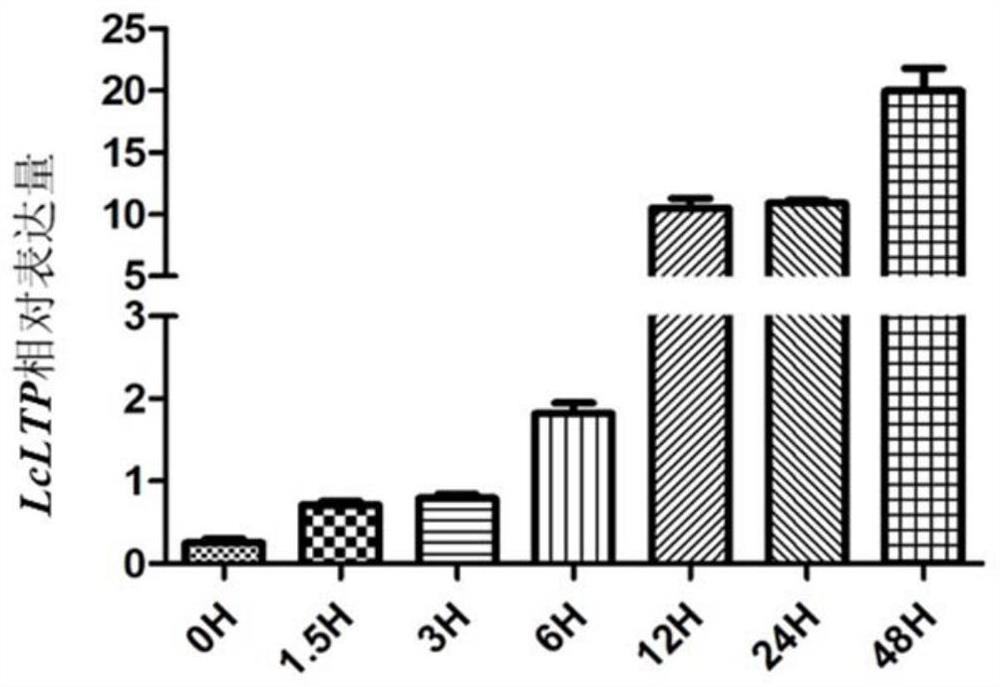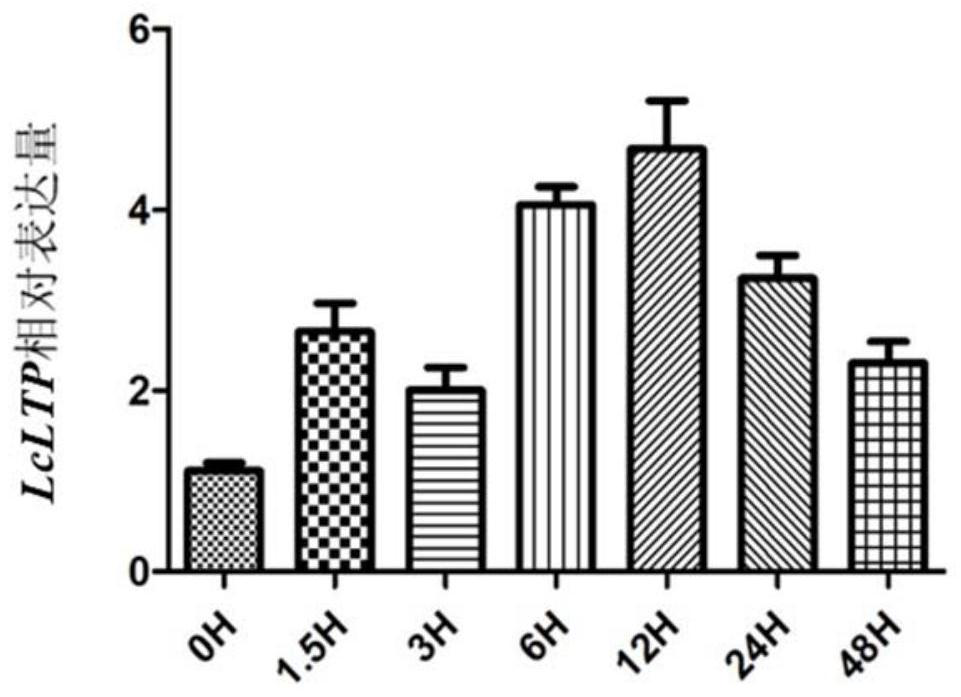Litchi disease-resistant gene LcLTP as well as encoding protein and application thereof
A disease-resistant gene and protein-encoded technology, applied in the field of molecular plant pathology, can solve problems affecting the occurrence of diseases, and achieve the effect of enhanced expression and reduced disease spots
- Summary
- Abstract
- Description
- Claims
- Application Information
AI Technical Summary
Problems solved by technology
Method used
Image
Examples
Embodiment 1
[0034] Embodiment 1: Cloning and acquisition of LcLTP gene
[0035] (1) Through the analysis of the litchi genome, it was predicted that the litchi may encode the LcLTP gene. We designed primers (upstream primer LcLTP-F and downstream primer LcLTP-R), and successfully cloned the LcLTP gene in the litchi cDNA. Its nucleotide sequence is as follows: Shown in SEQ ID NO:1, the amino acid sequence of its encoded protein is shown in SEQ ID NO:2:
[0036] LcLTP gene (SEQ ID NO: 1; base composition: 80A, 87T, 109G, 66C):
[0037] ATGGGAAGCACCAAGGGAACATCACTAGGTTTTATGGTATTAGTAGTTGTAGCTGTTGTGGGGAAGTGGGAGGTGAAGATGGCTGGTGCAGAACTTAGTGCAGCCCAGTGCAAGGAAGAGAGGAGAATTGGGCTGAATGAGTGCAAGCCAGTGGTGTATGGGAAGCTTCCGTCGCCGTCGTGCTGTGAGCGTGTAAGGGTGAGTCATGTTGAATGTGTGTGCCCTGTCATTACACCTAAGTTGGCTGCTCTTATTGATCTCAACCGTGCCATCCGCCTCATCGAAGGCTGCGGTAGAAGAGTCCCTCGCCACTTCAAGTGTGGAAGTATCACAACTCCTTGA。
[0038] LcLTP protein (SEQ ID NO:2):
[0039] MGSTKGTSLGFMVLVVVAVGKWEVKMAGAELSAAQCKEERRIGLNECKPVVYGKLPSPSCCERVRVSHVE...
Embodiment 2
[0047] Example 2: Transient expression of LcLTP in tobacco
[0048] (1) Tobacco transient expression vector construction:
[0049] ① The target fragment is connected to the carrier: the amplified LcLTP target fragment is connected to the PVX vector with homologous recombinase (linkage site: SmaI) to obtain a recombinant plasmid containing the sequence of SEQ ID NO: 1; the GFP sequence (SEQ ID NO: 3) Use homologous recombinase to connect with PVX vector (connection site: SmaI), obtain recombinant plasmid PVX::GFP containing GFP green fluorescent protein, after breeding in Escherichia coli JM109 strain, extract the plasmid, and recombined plasmid PVX::GFP and the recombinant plasmid containing the sequence of SEQ ID NO:1 were transformed into Agrobacterium GV3101.
[0050] GFP gene (SEQ ID NO: 3):
[0051] ATGGTGAGCAAGGGCGAGGAGCTGTTCACCGGGGTGGTGCCCATCCTGGTCGAGCTGGACGGCGACGTAAACGGCCACAAGTTCAGCGTGTCCGGCGAGGGCGAGGGCGATGCCACCTACGGCAAGCTGACCCTGAAGTTCATCTGCACCACCGGCAAGCTGCCCGTGCCCTGGC...
Embodiment 3
[0055] Embodiment 3: Zoospores infect litchi leaves and branches
[0056] 1. Cultivation of Pythophthora lychee
[0057] The hyphae blocks of Pyrosophthora lychee strains preserved in the laboratory were inoculated on the carrot medium, and placed in the culture room at 27°C for one week.
[0058] 2. Preparation of zoospore suspension
[0059] Pour sterilized water on the Lychee downy mildew plate, use a brush to collect the litchi downy Phytophthora mycelium through the filter in a 50ml centrifuge tube, place it at 18°C for 2 hours until it releases zoospores, when the sporangia are observed under the microscope After releasing the zoospores, the zoospore suspension was collected by filtration.
PUM
 Login to View More
Login to View More Abstract
Description
Claims
Application Information
 Login to View More
Login to View More - R&D
- Intellectual Property
- Life Sciences
- Materials
- Tech Scout
- Unparalleled Data Quality
- Higher Quality Content
- 60% Fewer Hallucinations
Browse by: Latest US Patents, China's latest patents, Technical Efficacy Thesaurus, Application Domain, Technology Topic, Popular Technical Reports.
© 2025 PatSnap. All rights reserved.Legal|Privacy policy|Modern Slavery Act Transparency Statement|Sitemap|About US| Contact US: help@patsnap.com



